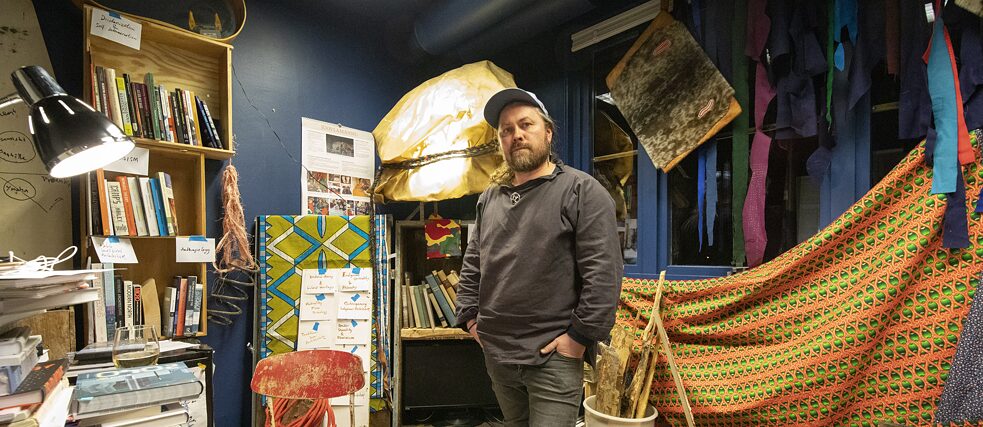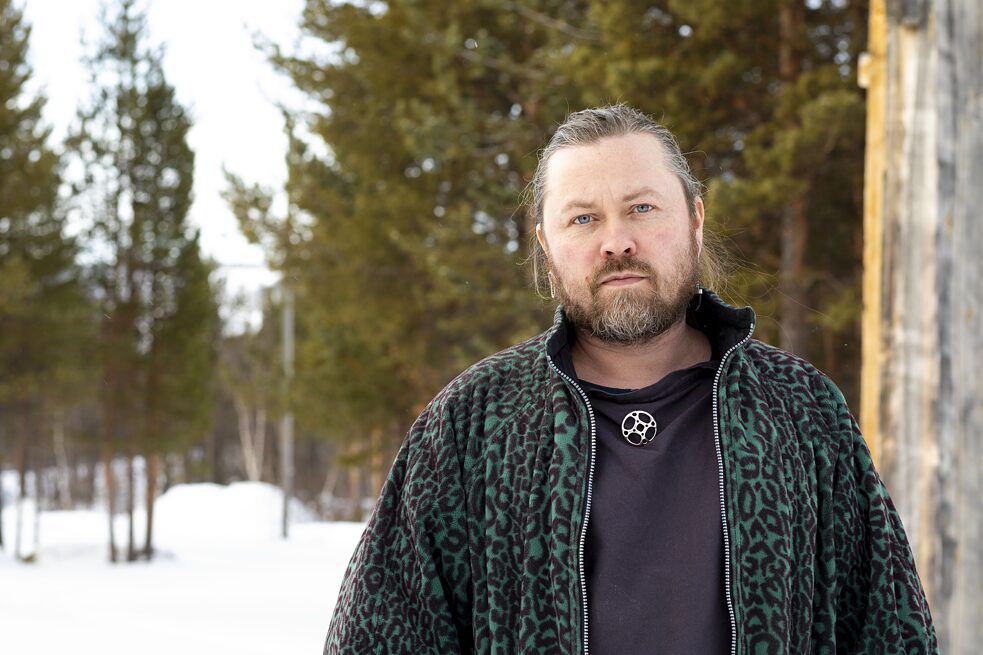Girjegumpi
Eye-opening art

“I avoid the term ‘decolonisation’ and find it difficult to identify with the term ‘indigenous communities’. From an early age I have identified as Sámi, whereas the concept of indigenous peoples is nothing more than a legal and political construct. Many terms like this are based on concepts that were created by colonisation itself. They might have some meaning on a political level, but are often used in a simplistic and categorising way,” explains architect and artist Joar Nango, who hails from Sápmi, the region traditionally inhabited by the Sámi people, during an interview with the artist and author Susanne Hætta.
By Susanne Hætta
Tromsø-based artist Joar Nango is frequently associated with the very terms he finds problematic. Over the past few years, he has toured his mobile exhibition ‘Girjegumpi – the Library of Sámi Architecture’ around Canada and many parts of Sápmi. The exhibition is currently on display at the National Museum of Art, Architecture and Design in Oslo. A certain dynamism is generated as the exhibition moves from place to place and continually changes with the addition of even more books and objects. The terms under discussion are key themes in contemporary discourse, not just in art but also in culture, politics and museology.
The snow is swirling around me as I arrive in Kárášjohka on a freezing cold day in March 2021. The Girjegumpi exhibition is on display at Sámi Dáiddaguovddáš (The Sámi Center for Contemporary Art). The word girjegumpi is derived from two North Sámi words: girje means books and a gumpi is a small mobile cabin on runners which is used during harvesting time in remote areas or when the Sámi herd their reindeer to different grazing areas. Wherever Joar takes his exhibition, whether it be Canada, Oslo or Harstad, he uses various resources that he finds in these locations to modify, expand or scale back his work. He also invites other people – and not just artists – to contribute to the exhibition. Here in Kárášjohka, the contents of the girjegumpi have been transferred from the mobile gumpi that was used when the exhibition was on tour to a room inside the art centre. It is not just filled with books on a wide variety of subjects but also with objects that Joar has received or created on his travels. A gentle light is emitted from a large lamp on a shelf that has a shade made from pieces of halibut skin sewn together. Meanwhile, strips of fabric and leather, baskets, pieces of wood and other indefinable objects all vie for attention. I would certainly define Joar Nango as a nomadic collector as this is an essential component of his artistic output.
I am keen to discuss with Joar my theory or opinion about the Sámi as an indigenous people, which I presume is fairly common in mainstream society and I believe contains a grain of truth.
 Joar Nango | © Susanne Hætta
Joar Nango | © Susanne Hætta
Joar Nango: That’s true but the Sámi are not the only people who can claim to be closely connected to wild landscapes and nature. There are other people working in the primary sector (in agriculture and forestry) in other parts of Norway who have a similar mindset to the Sámi in terms of the way they use natural resources and live in close harmony with nature. We also need to remember that there is a Sámi middle class living in the cities that has already lost this knowledge of the natural world. There’s a level of diversity among the Sámi people which has enabled us to develop some political clout. Many of those who later became Sámi politicians and played a significant role in society left their traditional lives, moved away to pursue training or education and stopped living so close to nature. Some of them had been Sámi activists during the Alta controversy. (Editor’s note: In the 1970s, Sámi human rights activists, conservationists and farmers protested against the construction of a hydroelectric power plant between Áltá and Guovdageaidnu. The protests were not initially successful but helped put Sámi rights onto the political agenda and led to the establishment of the Sámi parliament, the Sameting.)
Let's go back to your concepts and the way you think about the Sámi in your work.
I’m trying to coin new words from scratch in my work with Sámi architecture. I find it liberating to avoid buzzwords such as ‘sustainability’ or ‘indigenous knowledge’ – I find them incredibly loaded. I prefer to find new terms instead, like ‘indigenuity’. It is more meaningful and interesting to talk about because it is something I have constructed in my own mind. I can then discuss it more freely. Curators are looking for something that they can describe from the outside as holistic or as a holistic cosmology – and that's exactly what it is!
The terms nomadism and resettlement are often seen as the same thing. But I use the term nomadism very differently. I see it as being rooted in a cultural understanding that comes from studying Sámi architecture. Nomadism is the ability to discover landscapes and potential building materials wherever you might be. You might ask yourself whether this is particularly sustainable, but ‘sustainability’ is a generic, meaningless word. This is similar to the way the term ‘decolonisation’ is built around the concept of colonialism. Using the term is tantamount to kneeling before it and acknowledging it.
Washing off colonialism would be like casting off your own skin. So, how should we imbue the term ‘decolonisation’ with meaning?
We need to create new terms. It is more interesting to talk about ‘rematriation’ or feminism as part of the reversal processes and how to incorporate other goals when it comes to renegotiating the balance of power. This is what it is all about. ‘To indigenise’ (to ‘indigenise’ someone) as an alternative to ‘decolonisation’. Nobody uses the term ‘samify’. Nobody dares to, but why not?
So, ‘samification’ is the opposite of ‘Norwegianisation’?
The environment around us is not ready for this. We need to use the assets and interesting things within our culture to create new spaces such as this library of architecture. We must also use the knowledge we have acquired through our duodji (traditional, holistic and aesthetic Sámi skillsets), and from our nomadism and the ‘indigenuity’ of our architectural history. And we must also draw on the more recent way of thinking about indigenous philosophy that exists in our art. But we can be selective about the stories we choose. I think this is a good way to address the question concerning what decolonisation is trying to be, but I don't have to call it a ‘decolonisation library’ – it’s a girjegumpi.
As we continue our conversation, we discuss the books in the girjegumpi. I point out the ones I own myself and I suggest a few other titles to Joar. There are many books written all around the world that focus on indigenous architecture. By contrast, the girjegumpi is an ever-growing, dynamic body of work where there are no clear boundaries between specific categories: here there are books about the Sámi and indigenous art, about duodji, queer theory, poetry and many other social science disciplines. Joar and I leaf through many of the books. He reads out samples of text that reveal antiquated and archaic attitudes towards the Sámi people and ways in which the colonial powers would commonly describe indigenous people. As we sit beneath the gentle light of the halibut lamp, we ourselves become a part of the artwork. I’m sensing new insights and more knowledge... in fact a greater degree of curiosity. And this has been achieved most of all by these encounters between different people – open-minded, creative and questioning people who have walked into a girjegumpi.